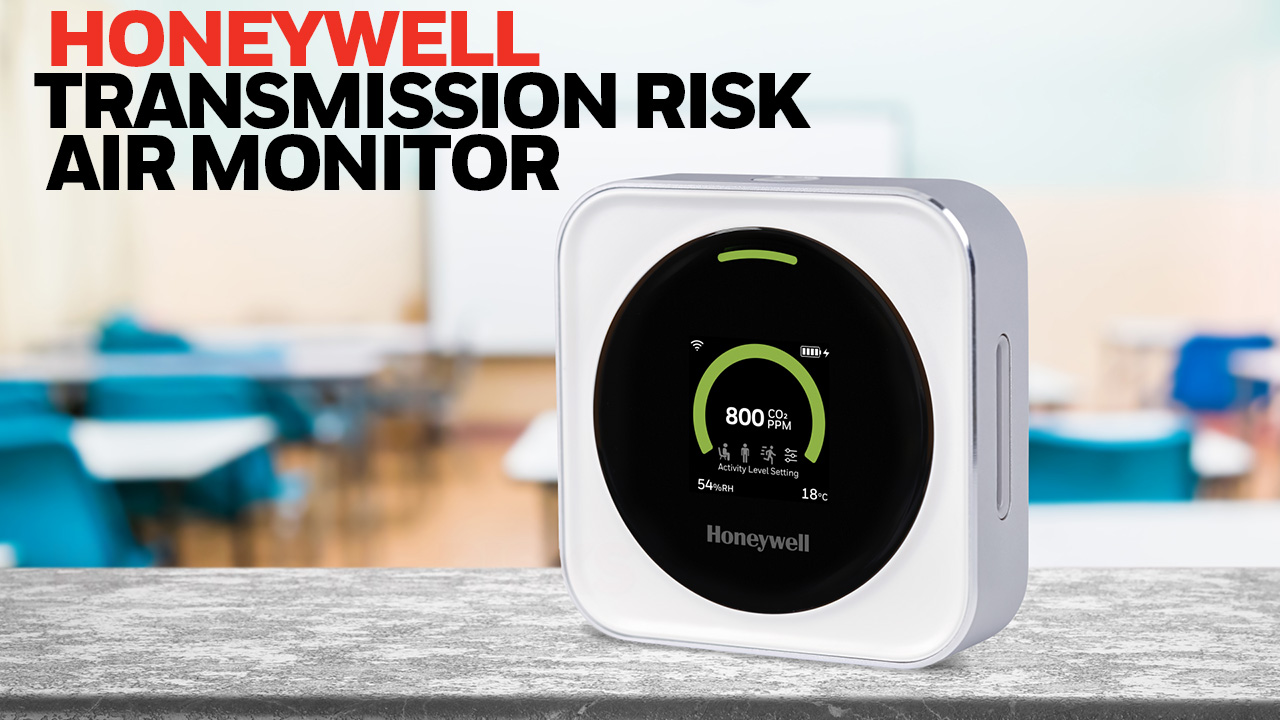-
Global
-
Africa
-
Asia Pacific
-
Europe
-
Latin America
-
Middle East
-
North America
- |
- Partners
- |
- SPS Blog
- |
- Contact Us
- |
-
Services
Services
-
Productivity
Productivity -
Safety
Safety -
Warehouse Automation
Warehouse Automation
-
-
Industries
Industries
-
Healthcare and Life Sciences
Healthcare and Life Sciences -
Transportation and Logistics
Transportation and Logistics -
Manufacturing
Manufacturing -
Distribution Centers
-
Retail
Retail -
E-Commerce
-
Infrastructure
Infrastructure -
Government
Government -
Aerospace and Defense
-
Electrification
-
-
Support
Support
-
Advanced Sensing Technologies
Advanced Sensing Technologies -
Productivity
Productivity -
Safety
Safety -
Warehouse Automation
Warehouse Automation -
Global Tracking
Global Tracking
-
You are browsing the product catalog for
We are simplifying air quality monitoring
The Honeywell Transmission Risk Air Monitor helps you monitor CO2 levels, coupled with user-controlled settings to account for human activity levels in an indoor area and alerts the user when conditions are present that may increase risk of potential exposure to airborne viral transmission.*
Small - to medium - sized spaces like classrooms, restaurants, and buildings with outdated HVAC and ventilation systems can foster environments where the risk of potential airborne virus transmission could increase.
Research conducted by scientists at the University of Colorado1, 2 has shown that real-time monitoring of indoor ambient air can be an indicator of increased risk of potential airborne viral transmission, utilizing different levels of risk-based factors such as CO2 concentration levels and the type of human activity in the area.
Features & Benefits:
- Monitor carbon dioxide, Temperature and Relative Humidity
- Use non-dispersive infra-red (NDIR) sensor for more accurate monitoring
- Three pre-programmed activity level settings (Low/Medium/High)
- Traffic Light Visual Indication (Green/Yellow/Red)
- Sound Alert: one beep for medium alert; two beeps for high alert
- Small portable size and light weight
- Easy-to-use one button setting
Honeywell Transmission Risk Air Monitor White Paper is now available
Check out the success story at Honeywell HQ
Review Honeywell Transmission Risk Air Monitor
Learn more about our Transmission Risk Air Monitor offerings, as well as view scientific research on CO2 correlation with airborne virus transmission risk; recent regulations and guidelines.
Learn about California’s 2020 School Reopening Ventilation and Energy Efficiency Verification and Repair Program legislation3
Review Economic Relief Details and Guidelines: CARES ACT, ARP (American Rescue Plan 2021) and more!
University of Colorado's professor Jimenez's most recent research on CO2 correlation with airborne virus transmission risk
Talk To an Expert. We Can Help.
Learn more or schedule a complimentary demonstration today. Virtual meetings are available
*The Honeywell Transmission Risk Air Monitor (HTRAM) analyzes specific air quality conditions and alerts the user when conditions are present that may increase the risk of potential exposure to airborne viral transmission. It does not prevent or reduce virus transmission nor mitigate viruses that may be present, nor does it detect or warn against the presence of any virus, including but not limited to COVID-19. Even at lower risk levels caution is required to prevent viral transmission. The HTRAM does not repel or destroy any microorganism, viruses, bacteria, or germs.
- COVID-19 Airborne Transmission Tool Available | CIRES (colorado.edu)
- Exhaled CO2 as COVID-19 infection risk proxy for different indoor environments and activities, Sept. 2020, https://www.medrxiv.org/content/10.1101/2020.09.09.20191676v1
- Buyer is responsible for determining whether the product is appropriate for use under certain international, federal, state or local guidelines, and is likewise responsible for determining whether the HTRAM qualifies for any government programs, including without limitation, reimbursement plans.
- It is buyer’s sole responsibility (1) to determine the suitability of the HTRAM for use in its application; (2) to operate the HTRAM in accordance with the User Manual and any other instructions provided by Honeywell and in compliance with all applicable laws, rules and regulations; and (3) to determine, based on buyer’s experience, expertise, and other available tools, the suitability of any product or service it may offer or recommend to the end user.
- Any recommendations or assistance provided by Honeywell regarding the use or operation of the HTRAM – through our literature, the Honeywell web site, or otherwise – shall not be construed as representations or warranties of any kind, express or implied, and such information is accepted at buyer’s own risk and without any obligation or liability to Honeywell.
- The information we supply in this data sheet is believed to be accurate and reliable as of this writing. However, specifications may change without notice, and Honeywell assumes no responsibility for its use.
- The HTRAM does not detect for levels of CO2 that would make for an unsafe or unsuitable breathing environment.
- This product contains a lithium-ion battery and aluminum alloy, and other types of materials. Upon receipt of the product, the customer is responsible for proper use, transport, storage, and disposal of the product based on the battery and material type, including but not limited to applicable governmental requirements for proper disposal.
Let's Connect!
Sign up to receive exclusive communications from Honeywell including product updates, technical information, new offerings, events and news, surveys, special offers, and related topics via telephone, email, and other forms of electronic communication.
Copyright © 2024 Honeywell International Inc




















































